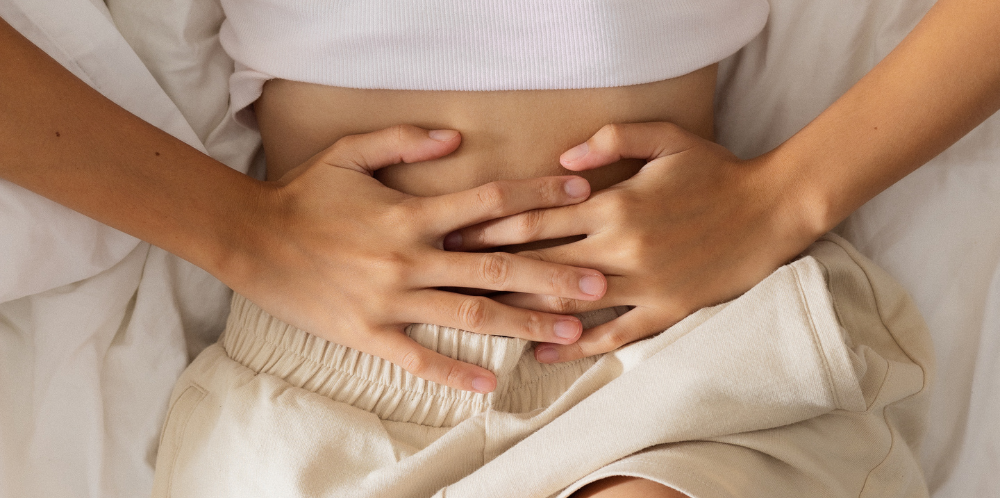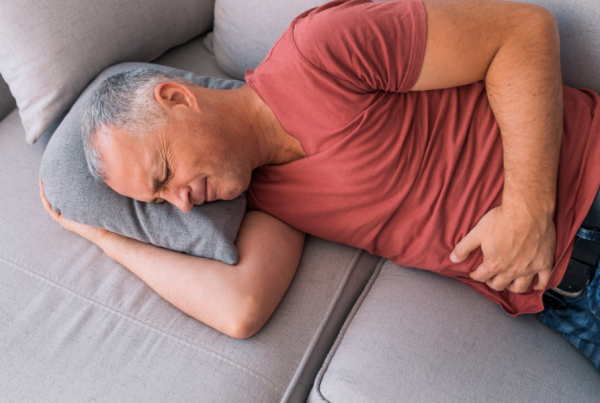Pelvic Adhesions
Move Better. Live Fuller. Your Wellness Journey Starts Here.
Schedule a FREE Discovery Call!
What Are Pelvic Adhesions?
Pelvic adhesions are bands of scar tissue that form between two organs or structures in the pelvic region, and cause them to stick together rather than glide smoothly against each other.
Adhesions commonly affect the fallopian tubes, uterus, ovaries and bladder, but can be found in other areas as well. This sticking of structures in the pelvis can create a variety of uncomfortable symptoms that vary from person to person.
Some individuals may not have symptoms, while others may experience any of the following:

- Pelvic pain
- Worsened menstrual cramps
- Back pain
- Painful sex
- Frequent urination
- Constipation
- Infertility
- Bloating
- Abdominal pain
Many of these symptoms are caused by the restrictions or pulling that pelvic adhesions cause, as this leads to restricted movement and pain. Additionally, nerve endings can become trapped by adhesions, leading to compressed or irritated nerves.
What Causes Pelvic Adhesions?
Adhesions form during the natural healing process that happens as a result of inflammation, other conditions, injury, or surgery. Pelvic adhesions commonly form in response to healing from the following scenarios:
- Surgery: The healing process after surgery is one of the most common causes of adhesions—including procedures such as cesarean sections, hysterectomies, appendectomies, and other surgeries.
- Endometriosis: This condition causes tissue similar to what is found in the uterus to grow outside of the uterus, causing inflammation that can lead to adhesions.
- Pelvic inflammatory disease (PID): Infections like PID can cause inflammation and damage to tissues that results in scarring and adhesions.
- Physical trauma or injury: Even without surgery, an injury or trauma can create inflammation or scar tissue in the body, which may lead to adhesions.
- Radiation therapy: Radiation treatments can damage tissues and create inflammation, which may cause adhesions as a result.
Physical Therapy for Pelvic Adhesions
Pelvic adhesions cannot necessarily be healed by direct treatments—there is the option to have them separated with surgery, but this increases the possibility of more adhesions forming as a result. Therefore, physical therapy is often utilized as a form of long-term management for symptoms caused by pelvic adhesions.
As mentioned before, adhesions cause pain from being too immobile and creating a pulling effect during normal everyday movements. Physical therapy can help adhesions and other related areas of the body become more mobile and flexible, which reduces pain and other symptoms that adhesions cause. Some ways physical therapists can reduce symptoms from pelvic adhesions include the following:
Tissue Mobilization
Scar tissue mobilization and soft tissue manipulation can increase mobility of adhesions and nearby structures, allowing for better flexibility, less tension, and reduced pain during movement. Working with scar tissue can even help with desensitization for people with painful scars or adhesions. Gentle mobilizations can lessen pain guarding and the tension that comes with it.
Strengthening and Stretching
Similarly to above, imbalances in pelvic muscles and the presence of tension in areas near adhesions can lead to less mobility and inhibited muscle function. Your physical therapist will work to ensure that the muscles in your pelvis, lower back, hips, and abdominals are balanced and flexible. This can be achieved by a curated exercise and stretching routine.
Posture
To combat pain and discomfort from adhesions, your physical therapist will address your posture and ensure your pelvis and other areas are in proper alignment. This is important because the limited mobility and movement caused by adhesions can create bad posture, which may exacerbate symptoms.
Pelvic Floor Health
Pelvic floor muscles are very interconnected with the entire pelvic area. Due to this, adhesions can create muscle tension and may cause pelvic floor dysfunction. Vice versa, having pelvic floor dysfunction may worsen the symptoms caused by pelvic adhesions—so your physical therapist will be sure to address any tension, weakness, imbalance, or lack of coordination found in your pelvic floor to prevent worsening of your symptoms.
Education
Your pelvic floor physical therapist can provide suggestions or modifications to your movements, postures, or activities to lessen strain on pelvic adhesions. This can include education on relaxation techniques, which may reduce stress and relieve muscle tension.
While pelvic adhesions may be difficult to avoid when it comes to accidents or surgery, you don’t have to live with the symptoms that adhesions can cause. Pelvic floor physical therapy is an effective way to manage pain and improve your quality of life! To help patients meet their health goals, Hive’s physical therapists create a comprehensive care plan for every person they treat—which may include any of the following treatment methods:
- Neuromuscular re-education
- Manual therapy
- Exercise prescription
- Dry needling
- Cupping
- Tissue scraping
- Behavioral modifications
- Therapeutic activities
- Electrical muscle stimulation
- Spinal manipulation
- Therapeutic modalities
- Biofeedback
Pelvic adhesions are bands of scar tissue that form between two organs or structures in the pelvic region, and cause them to stick together rather than glide smoothly against each other.
Adhesions commonly affect the fallopian tubes, uterus, ovaries and bladder, but can be found in other areas as well. This sticking of structures in the pelvis can create a variety of uncomfortable symptoms that vary from person to person.
Some individuals may not have symptoms, while others may experience any of the following:
- Pelvic pain
- Worsened menstrual cramps
- Back pain
- Painful sex
- Frequent urination
- Constipation
- Infertility
- Bloating
- Abdominal pain
Many of these symptoms are caused by the restrictions or pulling that pelvic adhesions cause, as this leads to restricted movement and pain. Additionally, nerve endings can become trapped by adhesions, leading to compressed or irritated nerves.
Adhesions form during the natural healing process that happens as a result of inflammation, other conditions, injury, or surgery. Pelvic adhesions commonly form in response to healing from the following scenarios:
- Surgery: The healing process after surgery is one of the most common causes of adhesions—including procedures such as cesarean sections, hysterectomies, appendectomies, and other surgeries.
- Endometriosis: This condition causes tissue similar to what is found in the uterus to grow outside of the uterus, causing inflammation that can lead to adhesions.
- Pelvic inflammatory disease (PID): Infections like PID can cause inflammation and damage to tissues that results in scarring and adhesions.
- Physical trauma or injury: Even without surgery, an injury or trauma can create inflammation or scar tissue in the body, which may lead to adhesions.
- Radiation therapy: Radiation treatments can damage tissues and create inflammation, which may cause adhesions as a result.
Pelvic adhesions cannot necessarily be healed by direct treatments—there is the option to have them separated with surgery, but this increases the possibility of more adhesions forming as a result.
Therefore, physical therapy is often utilized as a form of long-term management for symptoms caused by pelvic adhesions.
As mentioned before, adhesions cause pain from being too immobile and creating a pulling effect during normal everyday movements. Physical therapy can help adhesions and other related areas of the body become more mobile and flexible, which reduces pain and other symptoms that adhesions cause.
Some ways physical therapists can reduce symptoms from pelvic adhesions include the following:
Tissue Mobilization
Scar tissue mobilization and soft tissue manipulation can increase mobility of adhesions and nearby structures, allowing for better flexibility, less tension, and reduced pain during movement.
Working with scar tissue can even help with desensitization for people with painful scars or adhesions. Gentle mobilizations can lessen pain guarding and the tension that comes with it.
Strengthening and Stretching
Similarly to above, imbalances in pelvic muscles and the presence of tension in areas near adhesions can lead to less mobility and inhibited muscle function.
Your physical therapist will work to ensure that the muscles in your pelvis, lower back, hips, and abdominals are balanced and flexible. This can be achieved by a curated exercise and stretching routine.
Posture
To combat pain and discomfort from adhesions, your physical therapist will address your posture and ensure your pelvis and other areas are in proper alignment.
This is important because the limited mobility and movement caused by adhesions can create bad posture, which may exacerbate symptoms.
Pelvic Floor Health
Pelvic floor muscles are very interconnected with the entire pelvic area. Due to this, adhesions can create muscle tension and may cause pelvic floor dysfunction.
Vice versa, having pelvic floor dysfunction may worsen the symptoms caused by pelvic adhesions—so your physical therapist will be sure to address any tension, weakness, imbalance, or lack of coordination in your pelvic floor to prevent worsening of your symptoms.
Education
Your pelvic floor physical therapist can provide suggestions or modifications to your movements, postures, or activities to lessen strain on pelvic adhesions. This can include education on relaxation techniques, which may reduce stress and relieve muscle tension.
While pelvic adhesions may be difficult to avoid when it comes to accidents or surgery, you don’t have to live with the symptoms that adhesions can cause. Pelvic floor physical therapy is an effective way to manage pain and improve your quality of life!
To help patients meet their health goals, Hive’s physical therapists create a comprehensive care plan for every person they treat—which may include any of the following treatment methods:
- Neuromuscular re-education
- Manual therapy
- Exercise prescription
- Dry needling
- Cupping
- Tissue scraping
- Behavioral modifications
- Therapeutic activities
- Electrical muscle stimulation
- Spinal manipulation
- Therapeutic modalities
- Biofeedback
You can learn more about these treatments on our Treatments Page.





